R ohms
$L$ henrys
$C$ farads
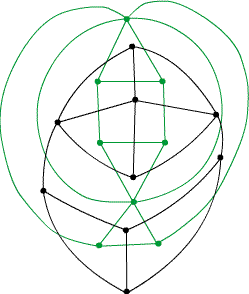
Construction of the (green) geometric dual to a (black) graph. There is a green vertex in the center of each black face; two are joined by a green edge if the black faces have an edge in common.
Here $G$ is the graph drawn in black; the geometric dual will be green. Put a green vertex inside each face of $G$, including the "outside" face. This vertex will be the dual of that face. Next if two of the faces of $G$ shage a (black) edge, draw a green edge between the two green vertices, which intersects the black edge in exactly one point. These two edges are dual. This gives all the edges of the geometric dual graph, and the faces they enclose (including an "outside" one) are the faces of the dual. Notice that the dual of a black $k$-valent vertex (i.e. one with $k$ incident edges) is a green $k$-gon; dually, the green vertex inside a black $j$-gon will have valence $j$.Suppose the black graph is oriented, in the sense that a direction has been picked along each black edge. Here is an algorithm —I learned it from Ernst Guillemin's Introductory Circuit Theory (Wiley, New York, 1953)— for orienting the green graph. Starting from the geometric dual, associate clockwise orientation of an edge of the boundary of a black face with the dual edge pointing outward from the dual vertex. This gives a green oriented graph. Next take a mirror-image reflection of that graph. This is the dual oriented graph. When this algorithm is applied to the dual oriented graph, it gives back the black oriented graph we started with.
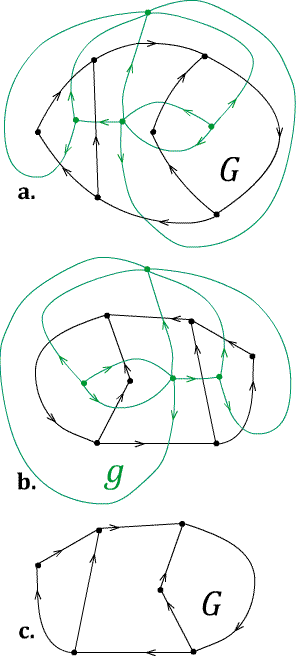
Illustration of the dual oriented graph algorithm and its reciprocity. a. Start with the oriented graph $G$ (black). Construct its geometric dual as above and orient its edges outward from a vertex if the dual edge is oriented clockwise in the dual face, inward otherwise. b. The mirror image of the oriented geometric dual is the (green) dual oriented graph $g$. To show reciprocity, construct the geometric dual of $g$ and orient its edges as above. c. The mirror image of that graph is the original oriented graph $G$.
| $X$ volt voltage source | $X$ ampere current source |
| $X$ ampere current source | $X$ volt voltage source |
| $X$ ohm resistor | $1/X$ ohm ($X$ mho) resistor |
A circuit $C$ has an undelying oriented graph $G_C$. We construct the dual
circuit $c$ on the
dual oriented graph: the edge dual to the edge $e_j$ of $G_C$ gets
the device dual to the device on $e_j$, following the table
above, respecting orientations.
Circuit duality principle: the equation solving
for the current in an edge of $C$ is identical to the equation solving for
the voltage in its dual edge $c$, and vice-versa.
Here is the simplest non-trivial example.
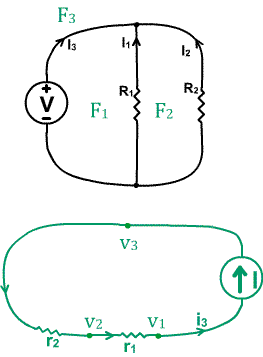
A voltage-resistor circuit $C$ (black) and its dual circuit $c$ (green), constructed as above. (The mirror-reversal is not significant at this stage, but is included for congruence with the treatment of reciprocity above).
We solve for the current $I_3$ in $C$ and for the voltage $v_3-v_1$ along its dual edge in $c$, using Kirchhoff's laws and Ohm's law as described in part 1 of this series.
| resistor R ohms |
$V_b(t)-V_a(t) = RI(t)$ | |
| inductor $L$ henrys |
${\displaystyle V_b(t)-V_a(t) = L\frac{dI(t)}{dt}}$ | |
| capacitor $C$ farads |
${\displaystyle V_b(t)-V_a(t) = \frac{1}{C}\int_{t_0}^tI(t)~dt}$ |
| $X$ henry inductor | $X$ farad capacitor |
| $X$ farad capacitor | $X$ henry inductor |
The simplest example of the duality principle now comes from these two dual circuits. (Adapted from lecture notes published at the School of Electrical Engineering & Computer Science, KAIST, Daijon, Korea.)
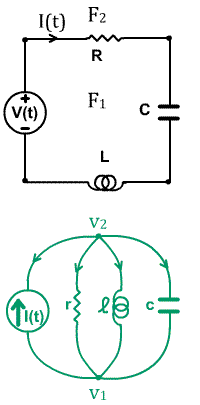
${\displaystyle -V(t)+RI(t)+\frac{1}{C}\int_{t_0}^t I(s)~ds + L\frac{dI(t)}{dt}=0}$
differentiating gives
${\displaystyle L\frac{d^2I(t)}{dt^2}+R\frac{dI(t)}{dt} +\frac{1}{C}I(t) = \frac{dV(t)}{dt}}.$
${\displaystyle -I(t)+\frac{1}{r}(v_2-v_1)(t)+ \int_{t_0}^t \frac{1}{\ell}
(v_2-v_1)(s)~ds + c \frac{d(v_2-v_1)(t)}{dt}=0}$
differentiating gives
${\displaystyle c \frac{d^2(v_2-v_1)(t)}{dt^2}+ \frac{1}{r}\frac{d(v_2-v_1)(t)} {dt} + \frac{1}{\ell} (v_2-v_1)(t) = \frac{dI(t)}{dt} }.$
Since (see table) $c=L$, $\ell = C$, ${\displaystyle\frac{1}{r}=R}$ and $I(t)=V(t)$, the expressions are identical.
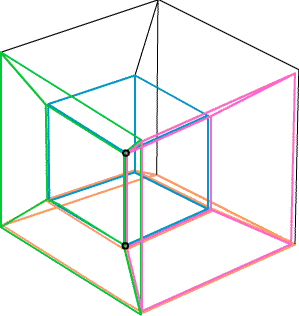
A cube in four dimensions is itself a 3-dimensional polytope. It has eight 3-dimensional cubes as its faces. (In this image, the eighth cube is the outside).